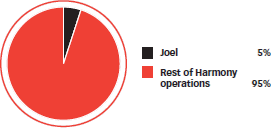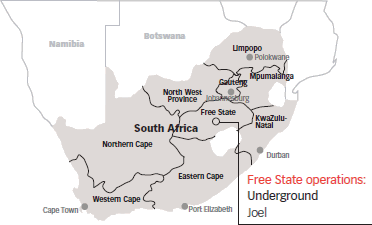![Harmony [logo]](i/logo.png)
![Harmony [logo]](i/print_logo.png)

- Home <
- Business review <
- Review of operations <
- South Africa <
- Joel
In this section
Joel
Contribution to group production – FY10


Description
Joel mine, which is located in the Free State, on the south-western edge of the Witwatersrand Basin, comprises two shafts, North and South shafts. Previously ore mined at Joel was transported to Central Plant, 38km away for processing but, since the recommissioning of the Joel Plant in November 2009, is now processed on site. Scattered mining takes place on the Beatrix Reef, down to a depth of some 1 400m. Upgrading of the infrastructure at North Shaft is currently in progress.
Joel employed 1 470 in FY10, of which 1 436 were employees and 34 contractors.
Detailed information on Joel’s resources and reserves are available in the Mineral resources and mineral reserves section of this annual report.
Safety
Safety performance at Joel deteriorated in FY10. Having had no fatalities for two years, there was tragically one fatality in FY10, the result of a rockfall, while the LTIFR for the year was 4.26 per million hours worked (FY09: 2.59).
More detailed information on safety performance and Harmony’s sustainable development concerns in South Africa can be found in the online Sustainable Development Report. A summary of this can be found under Harmony and sustainability.
| Production | FY10 | FY09 | FY08 | |
|---|---|---|---|---|
| Volumes milled | 000t (metric) | 439 | 513 | 407 |
| 000t (imperial) | 484 | 566 | 449 | |
| Gold produced | kg | 2 006 | 2 043 | 1 852 |
| oz | 64 495 | 65 684 | 59 557 | |
| Average grade | g/t | 4.57 | 3.98 | 4.55 |
| oz/t | 0.133 | 0.116 | 0.133 | |
| Financial | ||||
| Revenue | R million | 524 | 503 | 375 |
| US$ million | 69 | 56 | 52 | |
| Operating cost* | R/kg | 193 019 | 183 925 | 148 035 |
| US$/oz | 792 | 636 | 638 | |
| Operating profit | R million | 145 | 137 | 91 |
| US$ million | 19 | 15 | 13 | |
| Capital expenditure | R million | 88 | 56 | 39 |
| US$ million | 10 | 6 | 5 | |
| Sustainability | ||||
| Number of employees | ||||
| Employees | 1 436 | |||
| Contractors | 34 | |||
| Total | 1 470 | |||
| HDSAs in management** | % | 50 | ||
| Women in mining** | % | 10 | ||
| Expenditure on training and development | R million | 6 | ||
| Safety | ||||
| No. of fatalities | 1 | |||
| LTIFR | per million hours worked | 4.26 | ||
| Environment | ||||
| Energy used | 000MWh | 79 | ||
| Water used for primary activities | 000m3 | 682 | ||
| GHG emissions | 000t CO2e | 94 | ||
| Expenditure on local economic development | R million | 3 | ||
| Status of mining right | New order mining right granted in December 2007 | |||
* Includes royalty payment in FY10
** Indicator reported in terms of the MPRDA and the South African Mining Charter
† Includes Joel plant
Operations review
Despite a 15% improvement in grade mined, volumes milled declined by 14% to 439 000 tonnes in FY10, resulting in an overall decline of 2% in gold produced to 2 006 kilograms (64 495 ounces). The improved grade was a result of increased face grade in the west, greater vamping in the upper mine and reduced stoping widths.
Volumes mined were negatively affected by a mud slide at the bottom of North shaft, a guided rope shaft. A temporary mud press was subsequently installed and mud is removed daily from the bottom of the shaft. Despite this, raise boring of the North shaft expansion to 129 level was completed although hoisting constraints resulted in the equipping of the shaft deepening project to 129 level being delayed.
An extensive programme to rectify the problems experienced with North shaft had begun by the end of June 2010. While production at Joel has progressively moved to the deeper portions of the mine, some 1 400 metres below surface, the North Shaft, which accesses these areas, was never fully equipped for this and adjustments to the shaft spillage arrangements are now being made retrospectively. The modifications being made include: changing the winder from sinking to production mode; installing larger skips; ensuring that emergency egress is available; raise boring the lift shaft from 121 to 129 level; and improving cleaning arrangements at the shaft bottom.
Operations were halted while these changes were under way. The shaft resumed operations in August 2010, once repairs to the shaft bottom had been completed. In the interim, the Joel plant has been processing waste to maximise gold production. The opportunity will be taken to install the permanent spillage arrangement during December 2010.
Once mining from 129 level has begun, production is expected to peak at around 78 000oz annually at an average grade of 5.82g/t and an average cost in real terms of R180 103/kg. To ensure that these production targets are met, plans have been put in place to ensure the operability of the North shaft and conduct a planned maintenance programme to minimise breakdowns, to maintain blast advances and to assess the feasibility of mining below 129 level to 137 level. A successful drilling programme has been completed and a pre-feasibility study is in progress.
Financial review
Revenue increased by 4% to R524 million and by 23% to $69 million, boosted by the higher gold price. Cash operating costs in rand terms were contained, rising by 5% to R193 019/kg. Consequently, operating profit was up by 6% to R145 million (up 27% to US$19 million). Capital expenditure of R88 million was 57% higher than in FY09 mainly due to capital spent on the programme to upgrade the North shaft.
Outlook*
Production at Joel is expected to decrease marginally to 426 000 tonnes in FY11, while the average grade mined will rise to around 4.74g/t. Gold production will consequently be slightly higher at around 2 029 kilograms (65 234 ounces). Cash costs are expected to be approximately R217 085/kg (US$885/oz).
Total capital expenditure** planned for FY11 is R66 million (US$9 million) – R32million (US$4 million) on on-going development and R34 million (US$5 million) on major equipment maintenance and other shaft capital.
Current productivity levels of 125g/TEC are forecast to improve to an annual average of 152g/TEC during peak production.
* Please refer to the forward-looking statements
** June 2010 money terms. The exchange rate of R7.63/US$ as at 30 June 2010 has been used for all forward-looking conversions.
HARMONY ANNUAL REPORT 2010